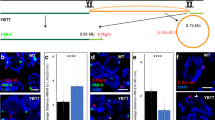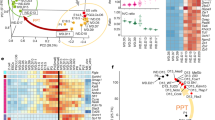Abstract
Xenopus and other amphibians possess two major classes of 5S RNA genes1. One class, which codes for somatic-type 5S RNA, is expressed in both oocytes and somatic cells2. The other class, which is 50 times more abundant and encodes oocyte-type 5S RNA, is expressed in oocytes but not in somatic cells2–4. The oocyte-type 5S genes are located in tandem arrays of hundreds of genes at the ends of most chromosomes5, and it has been postulated that the lack of expression of oocyte-type 5S RNA genes in somatic cells is due to some general characteristic of the chromosomal region which the genes occupy6, for example, a folding into heterochromatin or higher-order structures. An alternative possibility is that the inactivity of these genes is controlled individually, and is independent of adjacent genetic material. We have now distinguished between these two possibilities by testing the transcription of oocyte-type 5S RNA genes either in their normal arrangement on intact chromosomes or after each gene has been separated from its neighbours by micrococcal nuclease digestion. Transcription was assayed by injecting intact nuclei, containing the 5S RNA genes as chromatin, into Xenopus oocytes7. We find that the developmental inactivity of oocyte-type 5S RNA genes is retained after the chromatin is cleaved into fragments the size of individual gene repeats.
This is a preview of subscription content, access via your institution
Access options
Subscribe to this journal
Receive 51 print issues and online access
$199.00 per year
only $3.90 per issue
Buy this article
- Purchase on Springer Link
- Instant access to full article PDF
Prices may be subject to local taxes which are calculated during checkout
Similar content being viewed by others
References
Brown, D. D. & Sugimoto, K. Cold Spring Harb. Symp. quant. Biol. 38, 501–505 (1973).
Ford, P. J. & Southern, E. M. Nature new Biol. 241, 7–12 (1973).
Wegnez, M., Monier, R. & Denis, H. FEBS Lett. 25, 13–20 (1972).
Denis, H. & Wegnez, M. Devl Biol. 58, 212–217 (1977).
Pardue, M. L., Brown, D. D. & Birnstiel, M. L. Chromosoma 42, 191–203 (1973).
Ford, P. J. & Mathieson, T. Nature 261, 433–435 (1976).
Korn, L. J. & Gurdon, J. B. Nature 289, 461–465 (1981).
Peterson, R. C., Doering, J. L. & Brown, D. D. Cell 20, 131–141 (1980).
Federoff, N. V. & Brown, D. D. Cell 13, 701–716 (1978).
Carroll, D. & Brown, D. D. Cell 7, 467–475, 477–486 (1976).
Brown, D. D. & Gurdon, J. B. Proc. natn. Acad. Sci. U.S.A. 74, 2064–2068 (1977); 75, 2849–2853 (1978).
Gurdon, J. B. & Brown, D. D. Devl Biol. 67, 346–356 (1978).
Bogenhagen, D. F., Wormington, W. M. & Brown, D. D. Cell 28, 413–421 (1982).
Gottesfeld, J. M. & Bloomer, L. S. Cell 28, 781–791 (1982).
Gurdon, J. B. J. Embryol. exp. Morph. 36, 523–540 (1976).
Thomas, P. Proc. natn. Acad. Sci. U.S.A. 77, 5201–5205 (1980).
Author information
Authors and Affiliations
Rights and permissions
About this article
Cite this article
Gurdon, J., Dingwall, C., Laskey, R. et al. Developmental inactivity of 5S RNA genes persists when chromosomes are cut between genes. Nature 299, 652–653 (1982). https://doi.org/10.1038/299652a0
Received:
Accepted:
Issue Date:
DOI: https://doi.org/10.1038/299652a0
This article is cited by
-
Chromosomes for molecular hybridization
Histochemistry (1984)
Comments
By submitting a comment you agree to abide by our Terms and Community Guidelines. If you find something abusive or that does not comply with our terms or guidelines please flag it as inappropriate.



